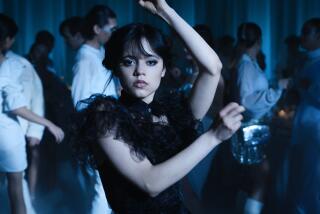Critic’s Notebook: Forget Halloween. TV shows have thrills and chills all year-round
For years now, television has greeted the end of October by rolling out special Halloween-themed episodes and slasher fare, but never before has it seemed so absurd. Not because Halloween isn’t socially significant — All Hallow’s Eve became an official American holiday when some genius thought up candy-corn lights and fog machines went retail — but because it’s redundant. On television, every night is Halloween.
Vampires, zombies, witches and werewolves — the dimly menacing figures that once stalked our dreams now swarm our DVRs. Americans, grasping at ghost stories as fast as their multitudinous anxieties will let them, have made hits of scare-TV..
“Grimm,” with its alternative universe of fairy tale-based beasties returned last week with potions and double-decker hexes. “American Horror Story,” having moved through ghosts, a mad scientist and witches, is conjuring a dark marriage between “Freaks” and a closet full of clown nightmares. Along with the horseman of the apocalypse (and the world’s creepiest version of the Pied Piper myth), “Sleepy Hollow” recently gave us a veiled and vengeful ghost. And only those who still thought of Comic Con as outlier were surprised when “The Walking Dead” became AMC’s first bona fide hit.
The seemingly benign dead haunt the flat screen in two languages — “Les Revenants” and “Resurrection.” But vampires continue to rule, even in the wake of “True Blood’s” final season. “Vampire Diaries” begot “The Originals,” while “The Strain” made the condition an easily spread disease. And, of all the highlighted Victorian Goths amassed by “Penny Dreadful,” none trumped the blood-sucking foe.
Lifetime recently gave us “The Witches of East End,” and WGN, entering the original drama business this year, followed suit with “Salem.” But demons are definitely making a comeback (“Sleepy Hollow,” “Constantine”), as is the devil (“Rosemary’s Baby” and the upcoming “Damien,” a TV continuation of “The Omen” movie franchise).
Seriously, as difficult as it is to close the gates of hell, it might be time to shut down a lane or two. Ghosties and ghoulies are frightening only if they’re not fighting over the remote control.
There’s nothing better than a good ghost story — even Edith Wharton loved to write them — and television has long dabbled in the supernatural, be it “The Twilight Zone” or “The Munsters,” “Bewitched” or “Buffy the Vampire Slayer.” But the number of damned and demonized we have unleashed upon ourselves of late should give us pause.
Certainly the “Twilight” juggernaut lit a torch, and lent a pitchfork, to the undead, which “Buffy” had already romanced. “Supernatural,” which will air its 200th episode next month, was the first real “Buffy” successor in 2005, but HBO was first out of the coffin post-”Twilight” with “True Blood.” The inter-species mating of hard-R horror with prestige TV (Alan Ball! Anna Paquin!) proved irresistible. Soon every network sported fangs, claws or rotting body parts, both exploiting and catalyzing the more general explosion of geek-fashion.
There’s more to the rise of mists and monsters than commercial copycatting. We call tales of the supernatural “horror” for a reason: As any student of myth knows, they allow us to explore our fears in a way that is as soothing as it is frightening.
Monsters are metaphors, and we are crawling with them because obviously we are very afraid of many things. Threats of a pandemic surface almost every year — how many headlines have been recently devoted to the “Ebola nurse”? — social media has revealed as much hate and pathology among its users as it has communion; politics are increasingly driven by anger and ruled by cabals, the economy makes less and less sense to anyone, and we are now in our second decade of a self-proclaimed war on terror with no victory in sight.
Is it any wonder our bedtime stories teem with predators who look but aren’t really human, with sudden invasions of dark angels and vampiric worms, with scrappy bands of supply-seeking survivors of a world divided clearly into “us” and “them”?
In the post-9/11 age, Americans wanted villains to defeat but the actual villainy quickly became too complicated for the epic tales required for real catharsis. We have come too far to brand entire nations, or faiths, as evil. We are mercifully too self-aware to ignore the ramifications of political and cultural complicity; even the morality of revenge became suspect.
So how much easier for everyone if those figures we considered Satan became literally Satan? Or at least one of his minions? How much clearer the roles if the “us” were simply humans, the “them” a bunch of decaying corpses/blood-sucking vampires/uncool werewolves?
These are battles we can all get behind. Families are strengthened, unlikely alliances are formed to fight real evil, even when that “evil” is the stereotyping of all vampires as predators or all witches as cruel.
In the world of horror, even the notion of social tolerance is simpler, represented by the recognition of “good” monsters (those still in touch with their humanity), and “bad” humans (those who behave more like monsters.)
Most modern horror series acknowledge the fragility of the line between monster and human, but none more than “The Walking Dead.” As deadly as the zombies remain, they have never been the true monsters of the piece, as each season makes clear. The real monsters are the living who succumb to rage or despair or their own dark natures. The real battle, for survival, for resources, for a stable, thriving society, is not “us” versus “them” — but “us” versus “us.”
We just need to figure out how to talk about it all without the vampire fangs, the hexenbiests and the crazy cannibals.
Follow me on Twitter: @marymacTV
More to Read
The complete guide to home viewing
Get Screen Gab for everything about the TV shows and streaming movies everyone’s talking about.
You may occasionally receive promotional content from the Los Angeles Times.







